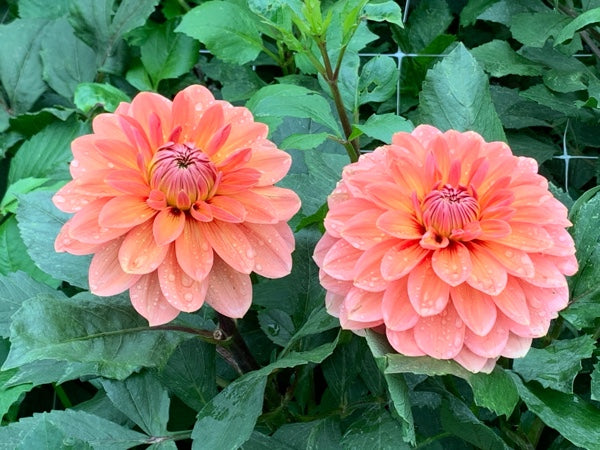Dahlia Tuber Care & Growing Tips
Dahlias can be very easy to grow, or very complicated, depending on who you're asking and how you approach it. Know that there are many opinions on best practices, and that no single way is always best.
The steps that will work best for you depend on your goals and your specific growing context. Best practices in the pacific northwest will be different from those in the northeast, which will be different from those in the south.
Enjoy the process of learning and experimenting, finding both challenges and success along the way. The tips below are what we feel work well in general. We hope that you'll find them helpful in your dahlia growing journey.
- Dahlia tubers are best stored in a cool dark location until you are ready to plant or pot them up for an early start. Do not allow them to freeze. They need enough humidity to prevent drying out, but not so much that they'll rot.
- Tubers from Valley Ridge Farm are generally shipped in a bag of vermiculite, which might be a good spot to hold until ready for planting. Just keep an eye on them. If condensation forms, open the bag to reduce humidity. If the tubers begin to shrivel, a single spray of water should be sufficient humidity in a slightly open bag.
- Plant tubers horizontally 4-6" deep, with the eye/sprout pointing upward if possible (it'll likely find its way regardless, but pointing it upward will help), in a well-draining spot after all threat of frost has passed. The ideal soil temperature is 50-60 degrees F. Tubers placed in colder (especially if wet) ground risk rotting as they wait for warmer days.
- Spacing of dahlia plants can be very different depending on who you ask. We space ours 12" apart here at Valley Ridge Farm, with 3 rows per bed. We would not recommend placing them any closer than 10", and some varieties might do best with 16" or more.
- Dahlias need very little water until the plants are 6”-12” tall. Tubers are prone to rot, so unless your soil is very dry, refrain from watering until sprouts appear. Throughout the season, dahlias need water more deeply but less often than many other garden plants. The water must penetrate 4" or more as that's where the roots are.
- As dahlias grow, provide support for all but the shortest varieties so they don't topple from wind or under the weight of their own blooms. If staking, it is best to place it at planting time or soon thereafter to avoid damaging new tubers later. With larger dahlia plots, it's often easier to provide a support system rather than staking each individual plant. Many use the corral method where 2-3 layers of twine are strung between t-posts on 8' spacing. Others use hortonova netting, with 1-3 layers stretched tightly across t-posts depending on plant height and how much wind your growing area receives.
- Your dahlias should begin producing flowers approximately 12-16 weeks after planting and continue to bloom until first frost.
- To encourage bushier plants and more blooms, give them a pinch once they've grown 3-5 sets of leaves, or about 12-16" tall. This is done by cutting the center stem immediately above a set of leaves, leaving at least 3 sets on the plant.
- To achieve the best possible vase life, cut from the plant early in the day, strip the lower leaves, and quickly place in water. Once in the vase, be sure to trim stems and replace water on a daily basis.
- In the fall, after the first killing frost (the plants will quickly turn brown), dig up your new clumps of dahlia tubers and store them for another year. Tuber dividing and storage is another discussion entirely, with wide-ranging opinions and varying best practices depending on each grower's specific context. We may tackle this in another section at a later date.
- Happy dahlia growing! We hope you experience an amazing season of blooms!

